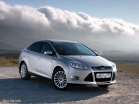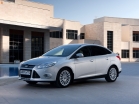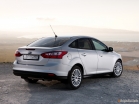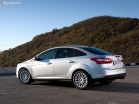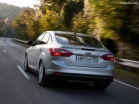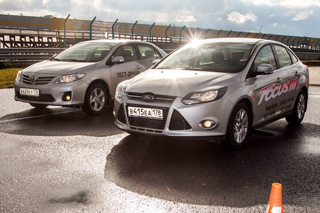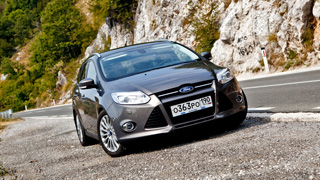Test drive Ford Focus sedan since 2010 sedan
Thick and thin
 It makes no sense to choose a car simply by characteristics and descriptions for a long time. Behind the promising formulation, a two -liter sedan can hide completely different in the ideology of the machine. Such as Ford Focus and Mitsubishi Lancer.
It makes no sense to choose a car simply by characteristics and descriptions for a long time. Behind the promising formulation, a two -liter sedan can hide completely different in the ideology of the machine. Such as Ford Focus and Mitsubishi Lancer. The heroes of Chekhov’s story are recalled at first sight of these two cars. The high and rounded Focus is emphasized much more well -fed than the long and low Lancer. And, like the characters invented by Anton Pavlovich, two classes of class C at first glance should differ little: both have a two-liter motor, a very popular body type and even similar details of the appearance-for example, triangular block fara. However, it makes it possible to understand that the end of one gymnasium did not guarantee officials the same career, so close numbers of technical characteristics do not mean a complete similarity of consumer qualities.
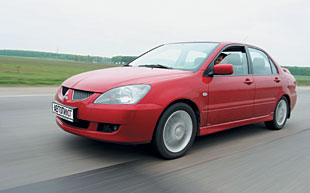 Mechanical piano. The fundamental difference in the concept manifested itself in choosing the type of transmission. Two companies directly contrasted the top versions of their popular models in our market: Mitsubishi sells Lancer in Russia exclusively with mechanics, but the two-liter engine combines only with an automaton. That is, the Japanese propose to squeeze the maximum, but the representative of the big three, on the contrary, found that the increased engine capabilities allow the owner to simplify life.
Mechanical piano. The fundamental difference in the concept manifested itself in choosing the type of transmission. Two companies directly contrasted the top versions of their popular models in our market: Mitsubishi sells Lancer in Russia exclusively with mechanics, but the two-liter engine combines only with an automaton. That is, the Japanese propose to squeeze the maximum, but the representative of the big three, on the contrary, found that the increased engine capabilities allow the owner to simplify life. Interestingly, the approach of Mitsubishi is shared by another Japanese brand - Mazda.
Of course, the matter was not without the point of emphasizing the idea of \u200b\u200bdynamics in Lancer design. The sedan comes to us only in the performance of Sport. Anti -wing on the trunk, rear lights with transparent diffusers
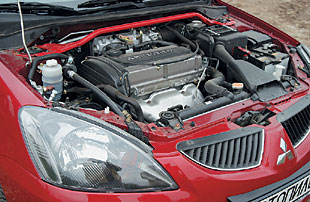 a la Evo VIII, slightly darkened headlights and cast 16-inch discs will let others understand that this is not just Lancer. And the owner himself will resemble the scales of ivory color devices with a very pleasant red backlight.
a la Evo VIII, slightly darkened headlights and cast 16-inch discs will let others understand that this is not just Lancer. And the owner himself will resemble the scales of ivory color devices with a very pleasant red backlight. But the two -liter Focus is no different from other modifications in similar performance. True, their choice is somewhat narrowed: the most powerful motor is not available in the cheapest Ambiente version. But it can be obtained in the other three. Our Focus was performed by Comfort, complemented by a winter package, which includes a very rare, but extremely useful option in our area - electric heating of the windshield. Compared to Lancer, this car looked quite modest. But Focus can also be obtained with electric windows for all
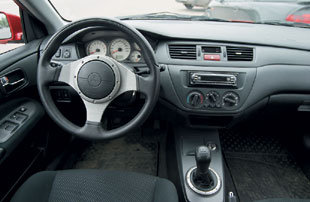 doors, and not only on the front, and with ABS - however, then the cost of Ford will even slightly exceed the price of Mitsubishi. Although we note that they do not offer side pillows for cars from Vsevolozhsk at all. Well, the glass heating looks quite adequate compensation: it will solve the owner’s problems for several months every year, but the side pillows may not be needed at all. Or should they be considered a sign of a machine for more aggressive driving?
doors, and not only on the front, and with ABS - however, then the cost of Ford will even slightly exceed the price of Mitsubishi. Although we note that they do not offer side pillows for cars from Vsevolozhsk at all. Well, the glass heating looks quite adequate compensation: it will solve the owner’s problems for several months every year, but the side pillows may not be needed at all. Or should they be considered a sign of a machine for more aggressive driving? Darling and Anyuta. The design of the machine is sufficiently similar: front -wheel drive, MacPherson in front, multi -link suspension behind. And both are quite good in combination of controllability, stability and comfort. Focus, of course, accelerates
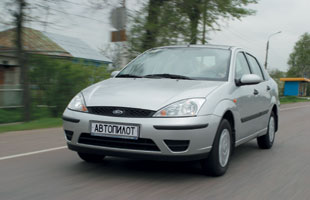 slow than Lancer - a hydromechanical transmission has a smaller efficiency than a simple mechanics. However, as the Chekhov shower easily adopted the interests of each of her husbands, so Ford is able to adapt to the driving style in a fairly wide range: from calm defiling in Tverskaya in search of a store and parking to the wrapping along the Moscow-Don highway. The point is not that its box is adaptive - it has a rather simple design to today. The fact is that the power supply is quite sufficient to prove to the majority if you want to prove that this Focus is a car for lovers of really fast driving. It is enough just to second the accelerator to the stop. The box begins to switch somewhere in the region of five to six thousand rpm instead of the usual three or four, and the car flies forward. The suspension allows you to make these tricks on a not very direct road, while quite delicate
slow than Lancer - a hydromechanical transmission has a smaller efficiency than a simple mechanics. However, as the Chekhov shower easily adopted the interests of each of her husbands, so Ford is able to adapt to the driving style in a fairly wide range: from calm defiling in Tverskaya in search of a store and parking to the wrapping along the Moscow-Don highway. The point is not that its box is adaptive - it has a rather simple design to today. The fact is that the power supply is quite sufficient to prove to the majority if you want to prove that this Focus is a car for lovers of really fast driving. It is enough just to second the accelerator to the stop. The box begins to switch somewhere in the region of five to six thousand rpm instead of the usual three or four, and the car flies forward. The suspension allows you to make these tricks on a not very direct road, while quite delicate 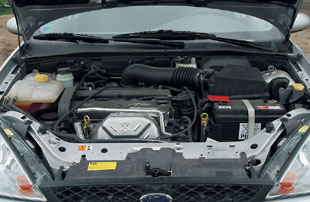 refers to the sensations of passengers and the driver, quite successfully masking the features of roads. Here, high-profile rubber helps her, although such a large car is not particularly to face. You can get the cast 15-inch, but for this you will have to choose a version of GHIA or pay $ 683.
refers to the sensations of passengers and the driver, quite successfully masking the features of roads. Here, high-profile rubber helps her, although such a large car is not particularly to face. You can get the cast 15-inch, but for this you will have to choose a version of GHIA or pay $ 683. The efforts of Mitsubishi in disputing Lancer were not in vain: a more rigid suspension with reinforced reptile stability stabilizers and tires with a profile height of only 50% on 16-inch cast discs provide an excellent coupling with the road. At the same time, the machine has retained a fairly decent level of comfort. Nevertheless, Lancer in this version is to a greater extent a means of getting pleasure from control than just a means of transportation. Like Anyuta from Anna on her neck, appreciating
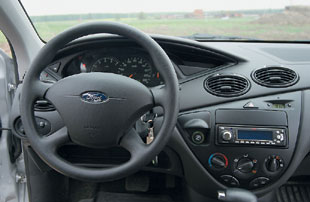 my attractiveness began to twirl her husband, so this car firmly and unequivocally declares that it is necessary to drive quickly. It's nice. But the legs should be sensitive: according to the Japanese tradition, the clutch pedal has a very long move. It would be nice to change it with the brake - after a precisely dosing force, it seems that Mitsubishi has two provisions: turned on and off. Although you get used to it pretty quickly.
my attractiveness began to twirl her husband, so this car firmly and unequivocally declares that it is necessary to drive quickly. It's nice. But the legs should be sensitive: according to the Japanese tradition, the clutch pedal has a very long move. It would be nice to change it with the brake - after a precisely dosing force, it seems that Mitsubishi has two provisions: turned on and off. Although you get used to it pretty quickly. It does not require time to get used to the lever of the gearbox with rather short moves and a very clear inclusion. Moreover, it can be used infrequently: the motor does not show special discontent when working at speeds close to the limit. Although only about 4000 he really comes to life. This manifests itself in a sound close to a real sports roar, and in the responsiveness of the machine to move the gas pedal.
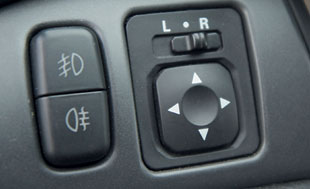 Brevity is the soul of wit. Unfortunately, in the city of Moscow and the adjacent environs there are not only the third ring and motorways on which the advantages of powerful engines are manifested to the maximum extent. Even on the same ring there are traffic jams where it is necessary to crawl - a condition in which Focus is better than Lancer by definition. And there are close parking lots that need to be entered and from which it is necessary to reject. Strange as it may seem, it is much more appropriate to Lancer: switching from the first to the reverse and back equally conveniently on both cars, but here is Focus trunk ... it is very high and completely blocks the opportunity to evaluate the dimensions.
Brevity is the soul of wit. Unfortunately, in the city of Moscow and the adjacent environs there are not only the third ring and motorways on which the advantages of powerful engines are manifested to the maximum extent. Even on the same ring there are traffic jams where it is necessary to crawl - a condition in which Focus is better than Lancer by definition. And there are close parking lots that need to be entered and from which it is necessary to reject. Strange as it may seem, it is much more appropriate to Lancer: switching from the first to the reverse and back equally conveniently on both cars, but here is Focus trunk ... it is very high and completely blocks the opportunity to evaluate the dimensions. 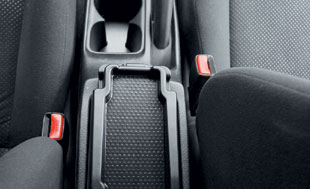 Several tiring parking lots ended with crooked smiles: it seemed to be so tormented, but it turned out that there was a reserve in a good meter and a half. It remains only to laugh at your excessive caution, but it is better to buy something like parking sensors. Or just buy a hatchback - the most popular body type in Europe, designers clearly paid maximum attention. And the trunk of the sedan in Focus looks almost like hanging equipment.
Several tiring parking lots ended with crooked smiles: it seemed to be so tormented, but it turned out that there was a reserve in a good meter and a half. It remains only to laugh at your excessive caution, but it is better to buy something like parking sensors. Or just buy a hatchback - the most popular body type in Europe, designers clearly paid maximum attention. And the trunk of the sedan in Focus looks almost like hanging equipment. Lancer has much easier with this: if desired, you can see the edge of the trunk in the mirror or at least the anti -wing, which part -time acts the role of the dimensional pointer. Only
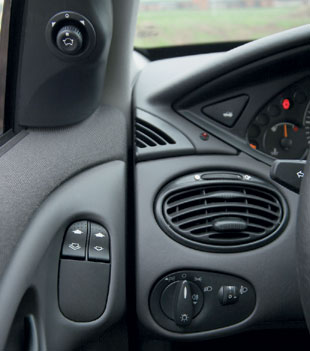 we must not forget to remove at least the middle of the rear head restraints. And better - everything. However, such a convenient and beautiful outside, from the inside, the Lancer trunk loses both in quantity and quality. Firstly, it is smaller: between 430 and 490 liters the difference is quite noticeable. Secondly, the lid without interior decoration looks somehow illogical in a car worth $ 20 thousand.
we must not forget to remove at least the middle of the rear head restraints. And better - everything. However, such a convenient and beautiful outside, from the inside, the Lancer trunk loses both in quantity and quality. Firstly, it is smaller: between 430 and 490 liters the difference is quite noticeable. Secondly, the lid without interior decoration looks somehow illogical in a car worth $ 20 thousand. The question of price arises not only at the time of purchase. To be the owner of Mitsubishi is not cheap pleasure. Although the interval interval for Lancer is now increased from 10 to 15 thousand km, Focus is ahead of the Japanese brand in this parameter: it should appear on the service only every 20 thousand. The result is this: the cost of all mandatory and recommended work, as well as spare parts that the car owner must pay for the first 60 thousand km of run, for Focus is approximately $ 900, and for Lancer $ 1170. Actually, there is nothing to be surprised here: the fact that the dealers of most brands, especially Japanese, earn more on spare parts and service than the sale of cars, is no longer a secret for anyone.
Text Valery Chusov, photo Tatyana Salyutova
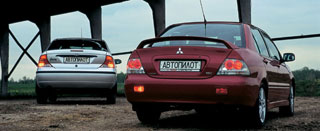
Ford Focus 2.0i Comfort Mitsubishi Lancer 2000 Sport
Gasoline engine, four -cylinder
Working volume (cubic cub) 1988 1997
Power (L.S. at rpm) 130 at 5500 135 at 5750
Moment (Nm at rpm) 178 at 4500 176 at 4500
Front front drive
Gearbox 4-speed automatic 5-speed mechanical
Length/width/height (mm) 4362/1702/1460 4480/1695/1415
Wheel base (mm) 2615 2600
Equipped mass (kg) 1186 1270
Maximum speed (km/h) 197 204
Acceleration to 100 km/h (c) 11.8 9.6
Fuel consumption (city/highway, l/100 km) 13.1/7.3 11.7/6.5
The price in Moscow is $ 17.85 thousand $ 19.39 thousand.
Source: "Autopilot"

